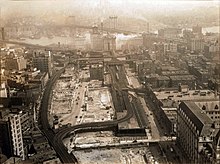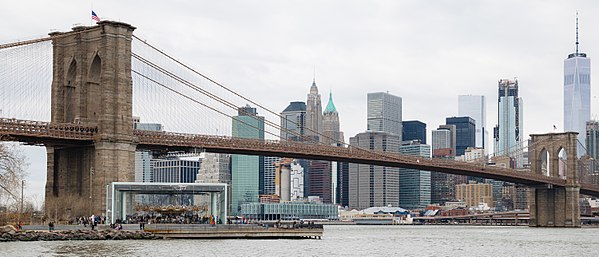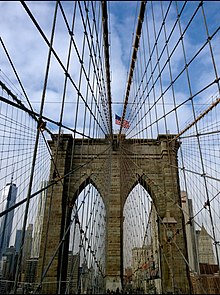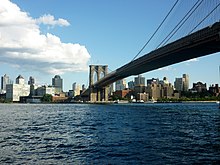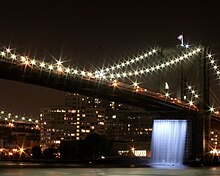Brooklyn Bridge
Coordinates: 40 ° 42 ′ 21 ″ N , 73 ° 59 ′ 48 ″ W.
| Brooklyn Bridge | ||
|---|---|---|
| Brooklyn Bridge looking towards Brooklyn | ||
| use | Road bridge, 6 lanes; Pedestrian and cycle path, also elevated railway until 1944, tram until 1950 |
|
| Crossing of | East River | |
| place | New York City | |
| Entertained by | New York City Department of Transportation | |
| construction | hybrid ( suspension and cable-stayed bridge ) | |
| overall length | 1833.68 m | |
| width | 25.91 m | |
| Longest span | 486 m | |
| opening | May 24, 1883 | |
| planner | John August Roebling | |
| location | ||
|
|
||
The Brooklyn Bridge (originally New York and Brooklyn Bridge ) in New York City is a combined suspension and cable-stayed bridge and one of the oldest suspension bridges of this type in the USA . It spans the East River and connects the districts of Manhattan and Brooklyn . Today the bridge has six lanes and a wide footpath and bike path on the level above. At the time of its completion in 1883, the Brooklyn Bridge was the longest suspension bridge in the world; it exceeded all previously erected in length by more than 50 percent. The Brooklyn Bridge quickly became a new landmark for the city of New York .
history
prehistory
The idea of a bridge between Manhattan and Brooklyn has been discussed since the early 19th century, but always failed because of the East River , which is not a river, but an inlet with strong tidal currents and heavy shipping. A bridge without annoying pillars, which crosses the arm of the sea far above the ship's masts in a large span, would have been the ideal solution, but at that time it seemed beyond all technical possibilities.
Preparations
The German-American engineer John August Roebling , who came from Mühlhausen in Thuringia, had already constructed several suspension bridges and in 1855 completed the Niagara Falls Suspension Bridge (also a combined suspension and cable-stayed bridge) with a span of 260 m. He was also the owner of a rope factory that could make wire ropes from high-strength steel wires. He suggested a suspension bridge, for which he had already worked out plans with numerous details, including the two large granite towers with the four suspension cables. The New York and Brooklyn governments were reluctant to respond. However, Roebling was able to inspire a businessman and newspaper publisher for the idea who, after lengthy efforts, succeeded in getting a New York State law that a private company could build a bridge over the East River. In 1867 the New York Bridge Company was founded. In 1869 Roebling's plans were approved and he himself was appointed chief engineer for bridge construction.
While visiting the space provided for one of the towers, Roebling was the victim of an accident in which his foot was crushed by a ferry. He died of blood poisoning just three weeks later. His son Washington then took over the management of the project.
construction
The actual construction work on the Brooklyn Bridge began on January 3, 1870 with the preparations for the foundations of the towers and the anchors. The excavation pits, which are up to 23 m deep, were excavated with the help of caissons , a method used for the first time in the USA, which has not yet been fully mastered and whose medical problems have not yet been understood at all. During the five years of civil engineering work, there were repeated accidents and illnesses. Washington Roebling also fell ill in 1872 while working in one of the caissons ( caisson ) for the construction of the pier foundations at the decompression sickness (the bends) or caisson disease . As a result, he only had limited ability to speak and was dependent on a wheelchair . While he could only follow the further construction work from home with a telescope , it was mainly his wife Emily who advanced the work. She would later also be the first person to cross the bridge after it was completed.

In August 1876 the first rope was stretched from one anchor over the towers and the East River to the other anchor, with the help of which a narrow, sagging catwalk was built. In February 1877 the spinning of the suspension cables began. The spinning wheels ran back and forth until October 1878 to pull the more than 20,000 steel wires for the four suspension cables across the river. In March 1879, work began on the deck girders, which lasted four years. In addition to the two lanes, two tracks were planned for the railway. Since their trains had become heavier in the meantime, Roebling had to provide reinforced struts in the half-timbered structures. Before the opening, the toll houses at both ends of the bridge had to be planned and built and the bridge itself had to be equipped with 70 electric lamps.
The total cost was $ 15.2 million including $ 3.8 million land acquisition costs. In total, the construction employed 6,000 workers, 27 of whom lost their lives.
Opening and first years
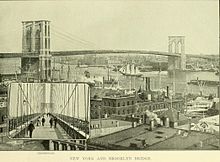
On the day it opened, May 24, 1883, 1,800 vehicles and 150,300 people crossed the new bridge. Five cents per vehicle and one cent per pedestrian had to be paid. In order to convince the skeptical New York population of the stability of the structure, the Barnum Circus , which had its winter quarters in Brooklyn , is said to have been sent over the bridge with 21 elephants for a stress test. However, there seem to be no reliable sources for this. According to some reports, this event did not take place until a year later.
It is unclear how the New Yorkers accepted the new bridge at the time. Sometimes it is said that everyone was enthusiastic and that hundreds of thousands crossed the bridge on the opening day. According to other reports, the population was initially very hesitant, so it should have taken a long time for this caution to subside.
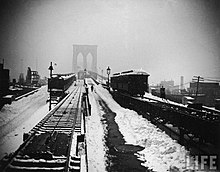
A few days after the opening, on May 30th, panic broke out in a crowd that killed twelve people. One woman screamed out loud when another lost her footing while walking on a wooden staircase. A mass panic broke out in the area within seconds, in the course of which twelve people died and 35 were injured, some seriously.
On September 25, 1883, train traffic over the bridge began on the tracks in the middle between the directional lanes on both sides of the footpath. At the ends of the bridges in Manhattan and Brooklyn, the route was continued as elevated railways to the nearby terminus. In the first few years cable cars , 24 of which were purchased, commuted between the two stations. These wagons were pushed by steam locomotives - which were not trusted to cope with the inclines of the ramps - from the terminal stations to the foot of the ramps. There the wagons were hooked into a continuously revolving rope that was moved by a steam engine on the Brooklyn side.
In 1884 around 9 million passengers were carried, in 1885 the trains were already running at 90-second intervals during rush hour. In 1893, to increase the capacity in the bridge area, intertwined tracks were laid and a second hauling rope installed. The use of steam locomotives ended on November 30, 1896, and from then on, electric railcars brought the trains - now made up of several cars - to the ramps, where the rope continued to provide traction. After the unification of the cities of New York and Brooklyn, the Brooklyn Rapid Transit Company (BRT) took over the New York and Brooklyn Bridge Railway in 1898 , linked the route with their existing ones and let some of their trains run through to Manhattan. The steam engine for moving the pull rope was replaced by electric motors. From 1899, trains also ran purely electrically across the bridge outside of rush hour without access to the cable.
In 1898 the streetcar connection was opened over the Brooklyn Bridge. The tracks were laid in the left lane of the two lanes next to those of the cable car.
20th century
Around 1900, crooks George C. Parker and William McCloundy sold properties allegedly owned by them, through which new access roads to the bridge were to run, to wealthy visitors to the city who were hoping for high returns. In the vernacular, the story soon got around that the two unsuspecting strangers had turned the bridge on themselves. "Selling the Brooklyn Bridge" has become a household word in the English language to this day for any kind of abuse of the good faith of others.
From October 1, 1901, cable traction was limited to the afternoon local trains during rush hour between the two banks of the river and ceased entirely on January 27, 1908. In 1944, the now ended for the New York City Subway belonging subway -Transport to the BRT tracks over the bridge, then on the tram took the tracks of the former cable car. 1954 also the streetcar traffic over the Brooklyn Bridge was stopped.
Extensive renovation and reinforcement measures were carried out between 1944 and 1955. In the process, the tram tracks were also recently removed and the bridge converted to six lanes for vehicle traffic. In 1999 the road surface was renewed and a number of reinforcing steel struts were used.
In January 1964, the bridge was granted National Historic Landmark status . In October 1966, the Brooklyn Bridge was added to the US National Register of Historic Places , the official list of sites and structures worthy of protection. On March 24, 1983, it was awarded the title of National Historic Civil Engineering Landmarks . In order to underline its outstanding architectural position, the bridge has been illuminated at night since the 1980s.
21st century
Since 2009, Brooklyn Bridge Park has been built at the foot of the bridge along the East River . A fundamental renovation of the bridge also began in 2009 and is ongoing (as of August 2016). After further damage was discovered during the renovation, the completion of the renovation work is delayed. It is expected to cost more than $ 600 million by the time the redevelopment is final. The bridge will remain open during the renovation work, but there are always partial and full closures for vehicle traffic, especially on weekends. The work was expected to be completed in 2016, but the planned completion date has now been postponed to 2022.
technical description
John August Roebling applied the same basic principles to the Brooklyn Bridge as to his earlier bridges: The bridge is supported by massive stone towers. The carriageway girder is a box-shaped truss construction, which by itself already has a high degree of rigidity in order to prevent the dreaded vibrations and twisting in storms. The track girder is not only hung from the suspension cables with vertical hangers, but also attached to the towers with stay cables. The dimensions are generous so that the bridge can withstand even large loads and heavy storms without damage. Although the Brooklyn Bridge was originally designed for horse-drawn carriages, ox wagons, and what was then the light railroad, it later survived the massive increase in road traffic and pedestrian crowds.
The Brooklyn Bridge has a total length of 1,834 m (6,016 ft) including the access ramps, which had to be kept flat due to railroad use. The length between the anchors of the suspension cables is 1068 m (3455 ft 6 in). In the main opening it has a span of 486.3 m and in the two edge openings one of 284.4 m each, which results in a total span of 1055.1 m.
The 25.9 m wide carriageway girder, which is divided into two halves, offers space for a total of six lanes, three in each direction. Originally there were four lanes and two tracks for suburban trains on the inner lanes, which were later converted into tram routes. In 1950 these tracks were also removed. A space in the middle is not designed as a lane, as it is taken up by the central pylons between the large portals. In the middle of the level above the carriageway there is a separate crossing for pedestrians and cyclists, which forks in half through the portal openings. A metal net is stretched horizontally in between.
The Brooklyn Bridge has a clear height of 41.15 m (135 ft) in the middle of the slightly upwardly curved deck. Towards the banks, the clear height decreases to 36.27 m (119 ft) at the pylons.
The two towers with neo-Gothic style elements are made of granite . The Gothic arched windows of the Divi-Blasii-Church in his German place of birth Mühlhausen / Thuringia are said to have served Roebling as a template . They have two pointed arch portals for the three lanes on the two halves of the lane girder, which accordingly each have two suspension cables. With a height of 48.50 m (159 ft) above the carriageway and 84.30 m above mean high water, the towers towered over all buildings at that time except for the spire of Trinity Church, which was a good meter higher. The foundations of the towers extend into the ground on the Manhattan side and 13.4 m (44 ft) on the Brooklyn side.
The Brooklyn Bridge was the first suspension bridge to use steel suspension cables . The four suspension cables are parallel wire ropes ; They consist of 5434 parallel steel wires , which are initially combined in 19 bundles of 286 wires each and then pressed together with large rope clamps to form the 40 cm thick suspension cables and sheathed with glowing wire. They were produced on site using Roebling's patented air-jet spinning process. A total of 1520 hangers made of normal, laid wire rope are attached to the suspension cables . In addition, a total of 400 stay cables were stretched between the spiers and the deck girder.
Roebling incorporated a large safety factor by designing the suspension cable construction for a load six times higher than necessary. This paid off when it was discovered during the work that a supplier had supplied poor quality wire. These were already installed and could no longer be removed. However, since the load-bearing capacity only decreased so much that the bridge could still cope with four times the load, it was left at that. A total of 24,000 km of wire was used for the ropes.
The weight of the bridge is approximately 13,300 metric tons (excluding towers, caissons and anchors).
Around 120,000 vehicles, 4,000 pedestrians and 3,100 cyclists pass the bridge every day. Use is restricted to vehicles up to 3.4 m high and 2.7 t total weight.
In art and media
- The Brooklyn Bridge, together with the Verrazzano-Narrows Bridge, is the focus of the film and musical Saturday Night Fever , both symbols of the path to a new world - to a glamorous career instead of dreary work. The backyard boy from Brooklyn dreams of the high society in Manhattan. The two worlds are separated by the East River, but the Brooklyn Bridge connects them, making it a place of hope for social advancement.
- Katharina Weingartner has the same motif in her film Sneaker Stories . In addition to Red Hook in Brooklyn, districts from Vienna and Accra are shown in which poor young people dream of getting rich playing baseball and then getting lucrative sponsorship from Nike etc. Weingartner contrasts Red Hook and the financial district of Manhattan, they are only separated by the river: since the dismantling of industry ... and the subsequent rise of black music and sports icons, it has become insurmountable, and yet the two districts are symbolically connected: How should a youth on grocery stamps in Red Hook eludes this myth?
- The longings run in the opposite direction in Leslie Kaplan's novel Brooklyn Bridge . For the main character, the final walk across the bridge represents the dreamed-of mental return to childhood, to home.
- The expressionist Robert Müller wrote the story Brooklyn Bridge in 1920
- In Richard Crabbe's historical thriller The Brooklyn Conspiracy , the Brooklyn Bridge is at the center of a dramatic era in the city's history.
- As one of the landmarks of the city of New York, the Brooklyn Bridge is the setting in numerous novels, television programs , films (e.g. Godzilla [1998], Deep Impact [1998], I Am Legend [2007]) and computer games (e.g. SimCity 3000 ).
- The documentary filmmaker Ken Burns made an Oscar-nominated documentary about the making of the Brooklyn Bridge in 1981 .
- In the summer of 2008, the Brooklyn Bridge itself was part of a large installation: The New York City Waterfalls was on view from mid-July to mid-October 2008. The Danish-Icelandic artist Olafur Eliasson had constructed several artificial waterfalls on a budget of 15 million dollars, one of them under the Brooklyn Bridge.
- Andreas Feininger created several photos of the bridge (including, for example: in the fog; at night) from different perspectives, which make a widespread poster motif. A rather unknown version, in which the bridge runs horizontally in front of the high-rise backdrop, serves as the cover image (front and back) of a Düsseldorf exhibition catalog about Rose Ausländer under the title I fly on the Europe - America - Europe aerial swing from 1994
- On July 22, 2014, two essentially white flags were recovered that were raised by strangers on the two pylons instead of the state flags. On August 13, 2014, two Berlin-based artists, Mischa Leinkauf and Matthias Wermke, declared themselves responsible for this action.
literature
- Richard Haw: The Brooklyn Bridge. A cultural history . Rutgers University Press, New Brunswick 2005, ISBN 0-8135-3587-5 .
- Washington Roebling: My father, John A. Roebling. The German builder of the Brooklyn Bridge . Edited by Donald Sayenga. Mitteldeutscher Verlag, Halle (Saale) 2011, ISBN 978-3-89812-731-8 .
- Rainer Nolden: The eighth wonder of the world . In: epoc , Vol. 3 (2008), pp. 12-19.
Individual evidence
- ↑ Schweizerische Bauzeitung TEC21, May 23, 2014, No. 21–22, p. 28 ( Memento of the original from August 26, 2016 in the Internet Archive ) Info: The archive link was inserted automatically and has not yet been checked. Please check the original and archive link according to the instructions and then remove this notice.
- ^ National register of historic places , accessed September 25, 2019
- ↑ a b c d e f Brooklyn Bridge - Historic Overview
- ↑ a b c d Brooklyn Bridge Facts, History, and Information ( Memento of February 8, 2010 in the Internet Archive )
- ↑ See decompression sickness # history of decompression research ; the first medical treatise appeared in 1869, the first relevant textbook for divers in 1878.
- ^ Dead on the new bridge. In: The New York Times of May 31, 1883 (pdf, English).
- ↑ Cable cars, trolleys and monorails: Moving around on New York's forgotten transit options at: boweryboyshistory.com, accessed September 25, 2019
- ↑ a b Cable Car Lines in New York and New Jersey at: cable-car-guy.com, accessed on September 25, 2019
- ↑ Stephen L. Meyers: Manhattan's Lost Streetcars , p. 109. at: Google Books, accessed September 25, 2019
- ↑ PCC trolley on Brooklyn Bridge at: pinterest.de, accessed on September 25, 2019
- ↑ Listing of National Historic Landmarks by State: New York. National Park Service , accessed August 19, 2019.
- ^ Brooklyn Bridge in the National Register Information System. National Park Service , accessed November 14, 2019.
- ^ Project Update August 1, 2016 from the New York City Department of Transportation (DOT) website, accessed August 26, 2016.
- ↑ Reuven Blau: Brooklyn Bridge repair is $ 100 million over budget, completion date gets pushed back again. In: nydailynews.com. March 2, 2015, accessed August 26, 2016 .
- ^ Sally Goldenberg: Already under repair, Brooklyn Bridge will need more work. In: capitalnewyork.com. September 1, 2015, accessed December 18, 2015 .
- ↑ No sleep until 2022 work = downtownexpress.com. Retrieved July 18, 2018 .
- ↑ Rainer Nolden: The eighth wonder of the world . In: epoc , Vol. 3 (2008), pp. 12-19.
- ↑ Brooklyn Bridge on the New York City Department of Transportation (DOT) website, accessed August 26, 2016.
- ↑ film 2008; DVD 2011; Info, pictures, press booklet ; accompanying teaching material for teachers online (PDF; 749 kB)
- ↑ sc. The myth of freedom and wealth. This refers to young people who live on social assistance. So KW in the interview "I think that the desire for freedom is also controlled by the unbridled greed of capitalism for new markets" , in Dschungel, supplement to jungle world , # 19, May 12, 2011, pp. 6-9, too on-line
- ^ Jörg Häntzschel: Waterfall under the Brooklyn Bridge. In sueddeutsche.de on January 17, 2008.
- ↑ http://iptv.orf.at/#/stories/2238956/ Rätselätze about mysterious flags, ORF.at report with video from July 22, 2014
- ↑ The art does not surrender. White American flags from Leinkauf and Wermke . In FAZ of August 14, 2014, p. 12.
Web links
- Brooklyn Bridge - extensive private website on the construction and history of the bridge
- John Stern, Carrie Wilson: The Brooklyn Bridge: A Study in Greatness , lecture on the occasion of the 125th anniversary of the opening of the bridge.
- Bernd Nebel: Brooklyn Bridge
- Driving across the Brooklyn Bridge in the 1930s on YouTube
- The new terminals of the Brooklyn Bridge in: Scientific American of October 19, 1895







